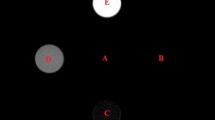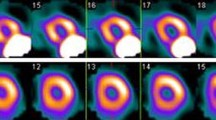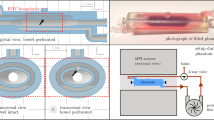Abstract
The aim of this study was to evaluate the use of a commercially available blueberry juice (BJ) both as a positive and negative oral contrast agent and to present the exact contents of paramagnetic ions. The concentration of Mn and Fe were determined in tinned myrtilles in syrup (atomic absorption). Nine healthy volunteers and 12 patients (age range 20–65 years) were examined using a 1-T MR scanner before and after per os administration of 430 ml of BJ. A qualitative analysis of signal alterations in the stomach, duodenum, and proximal small intestine was performed. In addition, a quantitative analysis was assessed in terms of signal-to-noise ratio calculation. The mean concentration (× ± SD) of the ions found in the content of the three cans were 3.3±0.4 µg/g for iron and 20.6±2.6 µg/g for manganese. Based on the qualitative evaluation, signal alteration on T1-weighted images after administration of BJ was statistically significant in the stomach and duodenum, but not in the proximal small bowel. Signal alteration on T2-weighted images was not statistically significant in any part of the gastrointestinal tract. The quantitative analysis of the T1- and T2 shortening showed that BJ is efficient with only T1-weighted sequences, and this applied to the stomach, duodenum, and proximal small bowel. Blueberry juice can be used as an oral contrast agent in upper abdominal MR for T1-weighted imaging.
Similar content being viewed by others
References
Rijcken THP, Davies MA, Ros PR (1994) Intraluminal contrast agents for MR imaging of the abdomen and pelvis. J Magn Re-son Imaging 4: 292–300
Saini S, Stark DD, Rzedzian RR et al. (1989) Forty-millisecond MR imaging of the abdomen at 2.0 T. Radiology 173:111–116
Bisset GS III (1989) Evaluation of potential practical oral contrast agents for pediatric MRI: preliminary observations. Pediatr Radiol 20: 61–66
Balzarini L, Aime S, Barbero L et al. (1992) MRI of the gastrointestinal tract: investigation of baby milk as a low cost contrast medium. Eur J Radiol 15:171–174
Cory DA, Schwartzentruber DJ, Mack BH (1987) Ingested magnanese chloride as a contrast agent for magnetic resonance imaging. Magn Reson Imaging 5: 65–70
Bernardino ME, Weinreb JC, Mitchell DG, Small WC, Morris M (1994) Safety and optimum concentration of a manganese chloride-based oral MR contrast agent. J Magn Reson Imaging 4: 872–876
Hirohashi S, Hirohashi R, Uchida H et al. (1997) MR cholangiopancreatography and MR urography: improved enhancement with a negative oral contrast agent. Radiologv 203: 281–285
Yamamoto Y, Hasegawa H (1993) Components of oral contrast agents for magnetic resonance imaging. Food Ingredients J 158: 102–119
Hiraishi K, Narabayashi I, Fujita O et al. (1995) Blueberry juice: preliminary evaluation as an oral contrast agent in gastrointestinal MR imaging. Radiology 194:119–123
Papanikolaou N, Karantanas AH, Heracleous H, Gourtsoyiannis NC (1998) MRCP using respiratory triggered 3D-TSE and breath-hold single shot TSE sequences before and after blueberry juice administration. Radiology 209 (P):484 (abstract)
Challa A, Papaefstathiou I, Lapatsanis D, Tsolas O (1995) Primary idiopathic hypomagnesimia in two female siblings. Acta Paediatr 84:1075–1078
Kaplan LA (1989) Trace elements. In: Kaplan LA, Pesce AJ (eds) Clinical chemistry: theory, analysis and correlation. Mosby, St. Louis, pp 532–542
Schreiber WE (1989) Iron, porphyrin and bilirubin metabolism. In: Kaplan LA, Pesce AJ (eds) Clinical chemistry: theory, analysis and correlation. Mosby, St. Louis, pp 496–511
Watson AD, Rocklage SM, Carvlin MJ (1988) Contrast agents. In: Stark DD, Bradley WG (eds) Magnetic resonance imaging. Mosby-Year Book, St. Louis, pp 372–437
Mitchell DG, Vinitski S, Mohamed FD, Mammone JF, Haidet K, Rifkin MD (1991) Comparison of Kaopectate with barium for negative and positive enteric contrast at MR imaging. Radiology 181: 475–480
Author information
Authors and Affiliations
Rights and permissions
About this article
Cite this article
Karantanas, A.H., Papanikolaou, N., Kalef-Ezra, J. et al. Blueberry juice used per os in upper abdominal MR imaging: composition and initial clinical data. Eur. Radiol. 10, 909–913 (2000). https://doi.org/10.1007/s003300051035
Received:
Revised:
Accepted:
Issue Date:
DOI: https://doi.org/10.1007/s003300051035




